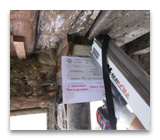Tests and surveys
Wood surveys
On-site inspection for the diagnosis of on-site elements
The diagnostic surveys applied to the wood in situ play a fundamental role in the study of wood diseases in order to determine the state of conservation and their performance capabilities in relation to static safety. To this end, with reference to the regulations in force, a working procedure is highlighted that allows the evaluation of the state of conservation and the strength of wooden elements in place to be evaluated by on-site inspections and through the use of non-destructive testing methods.
Micro-seismic and ultrasonic investigations
The purpose of this test is to characterise the homogeneity of the test material, or, if carried out in parallel with the fibres, to give an indication of density. This methodology involves passing pulse trains across the material, by ultrasonic devices using probes with frequencies between 15 and 20 kHz, and calculating the transmission rate accordingly, comparing them with various values.
Determination of the resistographic profile
The purpose of this test is to identify density variations between healthy and decomposed wood and to make a diagnosis of the internal areas of decay in the element under analysis. For this type of test, a tool is used to measure the resistance to penetration of a tip, 30 cm long with a diameter of 3 mm, which advances with combined movements of rotation and constant speed.
Evaluation of the modulus of elasticity using Pilodyn
The purpose of this test is to estimate the modulus of elasticity of wood based on appropriate correlations with the depth of penetration of a cylindrical punch that is "fired" against the surface at a constant force. The Pilodyn is set against the area to be tested and, using a spring trigger, fires a calibrated nail. This technique is applicable on the outer parts of wooden elements, influenced by the local conditions of the wood in the surface areas.
Endoscopic investigations
The aim of the endoscopic investigation is to classify in detail the consistency and nature of the material making up the structure being examined, by means of visual and photographic evaluations. For this purpose a probe is used, which is inserted into holes in the wood made by a milling machine or electric drill. The photographic or video feedback from the inspection allow the detection of any anomalies and cavities inside the wood.
Humidity measurement with hygrometer
The purpose of the hygrometer survey is to determine the moisture percentage present inside a wooden element. Generally, for outdoor use, it is sufficient to reach humidity values of around 15%, while if wood is used inside homes it is needs to be below 12%. The measurement provided by the instrument represents the percentage of water weight in relation to the dry weight of the material.

Venice
Surveys for strength classification as provided for in paragraph 7.5.1.3 of UNI EN 11119:2004.

